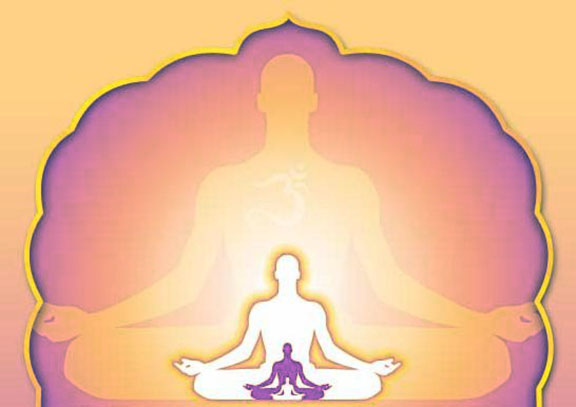 An ongoing debate concerns the subject of the relationship between Hinduism and Yoga. One side argues that westerners have appropriated Yoga and tried to divorce it from its Hindu roots. The other side argues that Yoga predates Hinduism and cannot be contained under one label or as belonging to any religion or group, that it is eternal wisdom. We asked Edwin Bryant, a professor of Hinduism, a scholar and a Yoga practitioner, to weigh in on the debate.
An ongoing debate concerns the subject of the relationship between Hinduism and Yoga. One side argues that westerners have appropriated Yoga and tried to divorce it from its Hindu roots. The other side argues that Yoga predates Hinduism and cannot be contained under one label or as belonging to any religion or group, that it is eternal wisdom. We asked Edwin Bryant, a professor of Hinduism, a scholar and a Yoga practitioner, to weigh in on the debate.
Integral Yoga Magazine (IYM): As you know, there’s always been a debate going on as to whether or not Yoga belongs to or is rooted in Hinduism.
Edwin Bryant (EB): The word “Hindu” was used by foreigners and that term doesn’t surface until the 16th century, long after Yoga originated. But let’s begin by accepting Patanjali’s Yoga Sutras as the text representing classical Yoga. The Yoga Sutras focuses on what Yoga is and what it consists of. Patanjali defines Yoga as the stilling of the states of mind. When that happens, the seer abides in its own nature. Otherwise, consciousness is absorbed in the mind. The goal of Yoga is to experience consciousness as distinct from the body and mind. Ethnicity, religion, culture and skin color are all various states of the body and mind.
The idea that we are having a discussion about whether Yoga is Hindu would be something I think Patanjali would have found to be missing the point. Patanjali clearly states that Yoga is that which takes you beyond the body and mind to what is common to all embodied beings: pure consciousness. The goal of Yoga is to not identify with the ego but to minimize, or remove, the false notion that I am the body and the mind—to see and experience oneself as pure consciousness. Yoga is that which takes us away from false identifications such as: “I’m Hindu,” “I’m Muslim,” “I’m American,” “I’m African”—or “this or that” belongs to “me” or “us.” Yoga situates us in a place beyond all that. Yoga is what takes us away from these mindsets; it’s transcultural.
IYM: Doesn’t Patanjali address this issue?
EB: Yes, if you read the Yoga Sutras carefully, there’s nothing that suggests it’s for a cultural tradition or ethnic community. In fact, in Chapter Two, sutra 31, Patanjali explicitly states that these practices are universal, going on to specify that they’re not tied to a community, country, time or condition. Yoga is not context specific. Sutra writing is minimalist, so it’s unusual for Patanjali to clarify or use redundant words. But, he makes a point of qualifying his statement that Yoga is universal, sarva bhauma, (an absolute term that needs no further qualification) by stressing that it’s for all people, in all times, at all places. When Patanjali describes the yamas, the first practice of the eight limbs of Yoga, he specifically says that they’re to be practiced irrespective of where you are born, in what community or time period. The yamas and niyamas are universal principles found at the heart of many traditions.
IYM: Some people may still argue that Yoga has its roots in Hinduism.
EB: Let’s examine the first references to Yoga, which surface in the Upanishads, the late Vedic texts. The Vedas are the oldest texts in the Sanskritic traditions and the later post-Vedic traditions would consider Yoga a Vedic knowledge system; something associated with a body of texts known as the Upanishads, seen as the higher Vedas (although archeologists have uncovered some seals that date much earlier than the Rig Veda that depict ascetics in seated postures like padmasana, which suggests something like this has been practiced for at least 5,000 years, that is, from before even the oldest of the Vedas).
IYM: How do the Upanishads differ from the Yoga Sutras?
EB: The Upanishads are Jnana Yoga; they deal with the ultimate nature of life and its goal. Mainstream religionists, at that time, were followers of Vedic culture, using rituals and mostly interested in material gain. But some became frustrated with rituals and turned to the Upanishads, with its higher goals of life beyond getting boons from rituals performed. They realized: Even if I get boons from the gods, that’s not freeing me from the cycle of birth and death—I’m still going to die! So they turned to the Upanishads and began seeking ultimate truth—beyond the lower gods, the rituals—to the atman or ultimate true Self. But, the Upanishads are not prescriptive texts telling us how to achieve the goal. The Yoga Sutras are prescriptive, they are about how to practice Yoga. The Upanishads talk about the atman and the goal of life being to seek the atman. Mostly, there are pedagogical exchanges between teacher and disciple, talking about seeking truth. There are a few verses that suggest a practice-specific way to find the atman but this isn’t developed or systematized in the way that Patanjali did later.
IYM: How did Yoga texts evolve from the Upanishads to Patanjali?
EB: The Upanishadic sages were forest dwellers, ascetics, who were teaching things about Yoga. They knew about atman from the time of the Upanishads, so the main question became: How does one realize this atman? Some were talking about Yoga practices involving six limbs, others about five limbs. Patanjali came along and (we can imagine) might have thought: Let’s systematize, preserve and standardize this body of knowledge and practice called “Yoga.” He wasn’t trying to convince us there’s an atman, he was writing for those who already accepted that from the Upanishadic tradition, but who wanted to realize it through practice. Patanjali synthesized a very practical and scientific system of Yoga. He tried to provide a technique, a system by which we can experience what is common to all human beings, that which is transcendent and is beyond possessions, mind, body, cultural or religious identities.
IYM: What would Patanjali have thought about the “Americanization” of Yoga, Pilates Yoga, Jewish Yoga, Christian Yoga and other forms?
EB: Patanjali would have been fine with Yoga coming to the west, as long as it corresponded to the core of the practices, which he outlined in Kriya Yoga and the eight limbs of Yoga that culminate in the stilling of the mind. Yoga transplanted in the west has been primarily the third limb, asana. But Yoga is meditation, or more precisely, stilling the mind. People who say, “I do Yoga,” and mean the physical postures alone, reflects the way Yoga has been understood in the west and that’s unfortunate. Remember, there are only three sutras that talk about the poses. That’s less than 1 percent: 10 words on asana out of 1200 words! If someone is taking the practice of Yoga while situating it in these different contexts, that’s fine. You can flavor Yoga with Islam or Judaism or Hinduism, with vocabulary that’s part of those traditions, and there’s no issue, because as long as you’re practicing the classical Yoga that Patanjali was prescribing, it will take you beyond identification with any religion, to a place of consciousness and awareness common to all. Perhaps a more productive conversation is: Does what we practice, under the name Yoga, correspond to what Patanjali outlined in the Yoga Sutras, with its eight limbs, vegetarian lifestyle and ultimately the stilling the mind? If we are seeking authenticity it makes more sense to talk about whether what we are doing in the west is the same as the practices that Patanjali is teaching, rather than its place of origin.
In Chapter Two, Patanjali discusses the kleshas, the psychic forces that perpetuate samsara. The reason we’re bound and suffering is because of ignorance—which means to ignore the Self. As ignorance becomes fine tuned to the contours of a particular body and mind it becomes asmita, ego. Patanjali defined ego as the state in which the seer and the instruments of sight are one and the same. Ego, the second klesha, is an extension of ignorance: to think I am the body and mind. To become enlightened we have to be free of or minimize the kleshas. So Patanjali defines Yoga as that which takes us beyond asmita, beyond identifications such as what I am culturally or where the body I am in for this particular life comes from. Asmita is ignorance, and he is giving us a technique to overcome it. If we practice classical Yoga, it can change our way of thinking so we experience our common core. Yes, the external part of us, for this one life, may be Hindu or Buddhist or Christian—what coverings we are presently conscious of may differ—but consciousness itself is the same.
IYM: Have you any final thoughts on the debate about whether Yoga is a religion or is tied to one?
EB: Yoga is not a religion; it’s not Hindu, not Christian, not Jewish. It’s a set of practices based on a specific understanding of what constitutes mind and consciousness. We can take the term and make it American, we can make it Hindu. We can make it anything we want but if we are talking about the sine qua non of Yoga, as understood from all the centuries back to Patanjali, it is to still the mind. It has to have that component or it’s not Yoga. Yoga was never depicted or understood by its location of origin or where it first surfaces in literary text. There’s never anything associated with Yoga that makes it specific to a language, skin color, religion or anything else—rather the opposite: Yoga takes us beyond all those things. Yoga is essentially meditation. It’s a practice that, when we do it, we give up these illusions that we are Hindus or Buddhists or anything. Hindu Yoga is an oxymoron. It’s like saying: Yoga is a Hindu practice that takes you to a realization that you are not Hindu. The goal of Yoga is to move beyond labels and identifications to the realization of the Self.
 Edwin Bryant, PhD, has practiced Bhakti Yoga for over 30 years. He received his doctorate in Indic languages and Cultures from Columbia University. He taught Hinduism at Harvard University for three years and is presently the professor of Hinduism at Rutgers University. He has received numerous awards and fellowships, published six books and authored a number of articles on Vedic history, Yoga and the Krishna tradition. His latest book, The Yoga Sutras of Patanjali with Notes from the Traditional Commentators, is one of the most respected works on the Yoga Sutras. For more information: www.edwinbryant.org.
Edwin Bryant, PhD, has practiced Bhakti Yoga for over 30 years. He received his doctorate in Indic languages and Cultures from Columbia University. He taught Hinduism at Harvard University for three years and is presently the professor of Hinduism at Rutgers University. He has received numerous awards and fellowships, published six books and authored a number of articles on Vedic history, Yoga and the Krishna tradition. His latest book, The Yoga Sutras of Patanjali with Notes from the Traditional Commentators, is one of the most respected works on the Yoga Sutras. For more information: www.edwinbryant.org.

